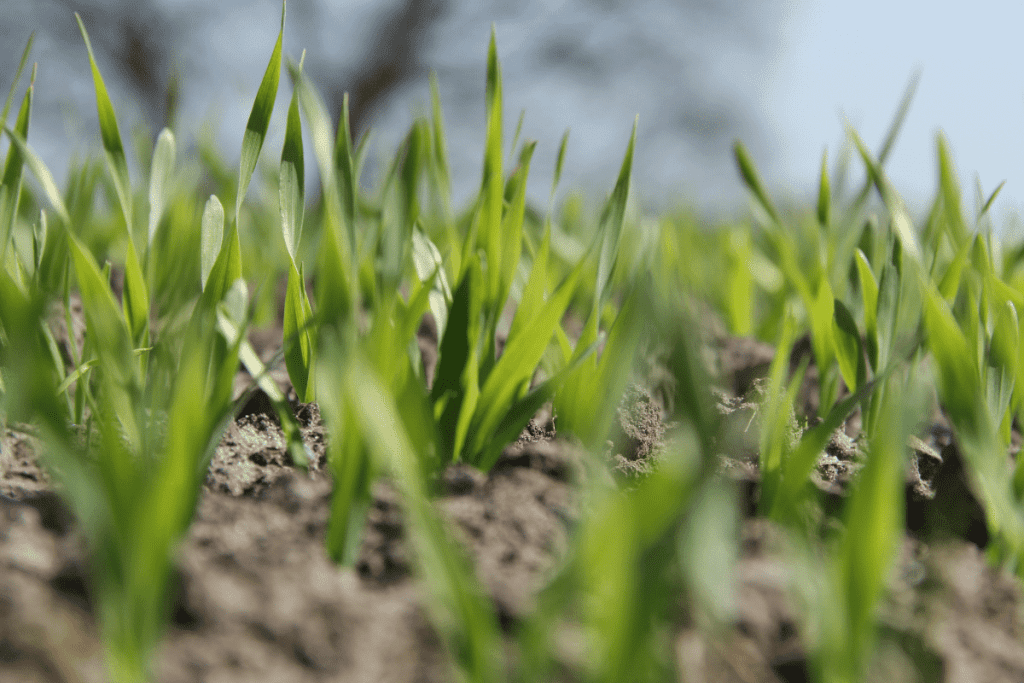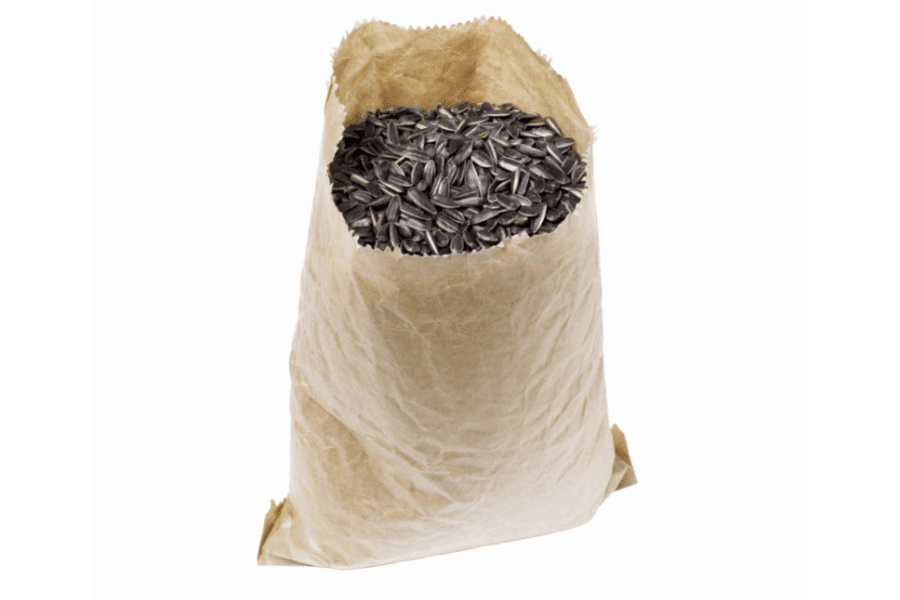Starting a new lawn from grass seed is a relatively simple process, but it takes a bit of extra work initially.
It is crucial to research the different types of grass seed, so you will know which one thrives the best in your particular climate.
But sometimes, despite your research, your grass seed just doesn’t grow.
This is where our article will come in handy!
If you have planted grass seeds, but they are not growing yet, keep reading for ten steps to take for getting your grass to grow.

Table of Contents
Check The Soil Temperature
The soil must be at the proper temperature for grass seed to germinate according to the grass type.
Warm soil conditions need to be consistent for at least 2-3 days before planting your grass seed.
Bermuda, Zoysia, Centipede, and other warm-season grasses need a soil temperature between 65-70° degrees Fahrenheit (21° C) to germinate.
Cool-season grasses like Rye, Kentucky Bluegrass, and Fescue require slightly cooler temperatures for germination between 50-65° degrees Fahrenheit (18° C).
Use either a soil temperature map or a lawn thermometer to monitor the temperature of the soil for several days before planting your grass seeds.
As a general rule, soil temperatures will be around 10° degrees cooler than ambient air temperatures during the day.
Seeding your lawn when the temperatures are incorrect will cause your grass seed to stay dormant until the proper temperatures are reached.
If your grass is not growing, check the soil temperature first to see if it is within the correct range for your grass type.
Water Before And After Seeding
Your soil needs to be adequately moist before and after seeding if you want germination to be successful.
The soil needs to be moist beyond the top layer, usually 6-8″ inches deep before seeding.
This equates to approximately an hour of watering time.
Once the seeds have been evenly spread and lightly covered, you will need to water the area again for around five minutes.
You will then water the newly planted seed for 5-10 minutes at least two times per day.
The soil needs to be kept moist for at least 1-2″ inches deep for the seeds to germinate properly.
If your yard has a lot of small hills, your grass seed may have patchy growth in the higher areas because it is not receiving enough water there.
If patchy growth is an issue for you, it is best to increase the watering frequency and duration to 3-4 times a day for 5-10 minutes per watering session.
Take care not to overwater the newly seeded area.
You want the ground to be moist, but you do not want any puddles of water or muddy soil.
If the seeds have not been raked into the soil correctly, you may even risk washing them away if you overwater the area.
Cover Grass Seed Properly
When you plant your grass seed, it needs to be covered in 1/4 to 1/2″ inches of soil.
If the grass is buried too deeply, it will not reach the soil’s surface.
If you do not adequately cover the grass seed with soil, it will be less likely to germinate.
Leaving the grass seeds exposed makes them more susceptible to wind and rain.
Birds and other animals may also eat the seeds.
After sowing the seeds using a broadcast spreader, gently rake them until the proper amount of soil covers them, and then use a lawn roller to press the soil onto the seeds.
This last step ensures proper seed-to-soil contact and increases the germination rate.
Check out our guide on how much peat moss is needed to cover grass seed.
Keep Off Of The Newly Seeded Area
After planting the grass seed, it is important not to walk on the newly seeded area for four weeks.
It is also best to avoid walking on areas where the grass has just sprouted.
Even grass sprouts just under the soil’s surface will be damaged or killed if they are walked on too soon.
If you continue to use your lawn as you normally would, you will effectively ruin any efforts you have made to grow new grass.
Completely avoid walking on the newly-seeded area or allowing your pets on the fresh lawn until the grass is fully mature and well-established.
Monitor Sunlight

Lack of sunlight will have a significant impact on seed germination.
Cloudy weather or shady areas of your lawn will prevent the newly-sprouted grass from getting the sunlight it needs to grow.
As a result, the young grass may begin to start dying in the shady parts of your lawn.
Partial shade or cloud cover may also lower the soil temperatures, causing your grass seed to have reduced or slow germination.
If parts of your yard do not get adequate direct sunlight, use a grass seed blend specifically formulated for shady spots.
If the weather has simply been cloudy in the days after you planted the grass seed, wait a few more days for the weather to change.
Once the sun comes back out and shines on your lawn, you will likely notice an increase in your grass growth.
Test Soil pH
If you did not do soil testing before planting your grass seed, it may be the reason your grass is not growing.
If the pH of your soil is incorrect, the grass seed will not grow.
The pH of the soil will tell you how alkaline or acidic it is.
It is easy to test your soil with an at-home testing kit, or you may be able to send your soil samples to a university extension for a complete analysis.
A soil pH between 5.8-7.2 is optimal for healthy grass growth.
Many types of grass do well in slightly acidic soil with a pH between 6.2-7.
Using lime on your soil before being tested is a bad idea because the pH may rise so high it will stop grass growth altogether.
Correcting the pH of your soil will make a huge difference in the results you will get from seeding your lawn.
The healthier soil will not only encourage your grass to grow, but it will also help to prevent weeds.
After your soil has been thoroughly tested, it is crucial to use the proper amount of lime or other types of soil amendments recommended from the test results.
Fertilize The Soil
Newly planted grass seed needs the right amount of essential nutrients for healthy growth.
If you have recently seeded your lawn and do not see optimal growth, you may need to add fertilizer to your soil.
A lawn-starter fertilizer will contain high amounts of nitrogen to encourage seed germination and phosphorus to promote strong root growth.
Most lawn-starter fertilizers are slow-release, which means they are safe to use on newly planted seeds because there is no risk of over-fertilizing.
It is best to spread the fertilizer on the same day you plant the grass seed.
If you have already planted your grass seeds and are not seeing any results, it is still possible to add fertilizer to your lawn and increase the number of nutrients in the soil.
Avoid Pre-Emergent Weed Killers
Pre-emergent weed killers are designed to kill weeds as soon as they sprout.
While this type of weed control works very well against crabgrass and broadleaf weeds, it will also kill your grass seed when it germinates.
Because pre-emergent weed killer stays in the soil for a long time, there are waiting periods you must follow if you want to plant grass seeds.
You will need to wait at least eight weeks after applying a pre-emergent weed killer before planting your grass seed.
Once the grass seed has been planted, wait at least six weeks before applying a pre-emergent weed killer.
If you had used a pre-emergent weed killer like a crabgrass preventer less than eight weeks before you planted your grass seed, the herbicide has probably killed the grass seeds after they germinated.
If you suspect this is what happened, you will have to wait for at least eight weeks until the pre-emergent weed killer is no longer effective in the soil before you re-seed your lawn.
Aerate The Soil
If your soil has a high clay content, or it is especially hard or compacted from foot traffic, your grass seed may not be able to push through the soil to germinate or sprout.
The grass seed may also be unable to receive the water and nutrients it needs to grow.
To solve this issue, you will need to aerate your soil and remove any debris such as thatch or dead grass.
If you have a large soil area, you may want to rent a dethatching machine to remove the layer of thatch and a core aerator to break up the compacted soil.
Compacted soil is usually the result of heavy traffic by people or pets or from heavy lawn care equipment.
If the soil is not getting enough water, it will only exacerbate the problem.
Your grass seeds will not be able to germinate under these conditions, and you may need to re-seed after aerating the soil.
Check The Seed Bag Label

If you have planted your grass seed and are not seeing any signs of growth, you may want to check the label on the seed bag.
This seed tag is found on every bag of grass seed, and it includes a wealth of information such as the type of grass seed, germination rate, and application instructions.
If you have not planted your grass seed according to the application rate, your seeds may not germinate, or you will see sparse growth.
It is usually recommended to seed at a rate of 1.5 times what it says in the instructions to account for seeds that fail to sprout.
This is a good practice, but take care not to overdo it.
Planting too much grass seed in one area means each seed will have to compete with more seeds for resources, and your new grass may suffer as a result.
If your bag of grass seed contains a grass seed mixture, they may germinate at different rates.
If your new grass has sprouted, but the coverage appears to be very thin, check the bag to ensure another type of seed is mixed in.
It may take a few more days for the other grass type to sprout and fill the thin coverage areas.
Grass seed goes bad too, so be sure to check the bag for this information.
Also head over to our article on how long grass seed may be stored before it goes bad.
Commonly Asked Questions
When should I stop watering new grass seed?
The top 1/2″ inch of soil needs to remain moist at all times until the grass is 1″ inch tall.
Once the grass grows to 1″ inch tall, you may reduce the watering frequency to every other day until the grass becomes established at around three weeks.
After three weeks have passed and your grass has become well-established on your lawn, you will only need to water it once or twice per week.
The new grass needs at least 1″ inch of water every week, either through rainfall or watering sessions.
While your new grass needs adequate water to grow and thrive, take care not to overwater it.
Overwatering will cause the grass to wilt and become discolored, and the excess moisture will make your new grass more prone to fungus and mold growth as well as disease.
Can new grass seed survive a frost?
Frost will not kill your grass seed, but it is important not to plant grass seed when there is any danger of frost happening.
Typically, when temperatures are too low to be favorable for growth, the grass seed will enter a state of dormancy.
Once soil temperatures reach acceptable levels, as mentioned above, the seeds will exit their dormant phase and begin to germinate.
However, if the seeds have already begun to sprout before the frost arrives, they will not survive.
You will likely have to re-seed when warmer and more stable temperatures.
What happens if I miss a day of watering grass seed?
If you miss a day of watering your new grass seed, it is vital to water it as soon as you remember.
If the soil dries out, so will the grass seeds, and they will fail to germinate and grow.
You need to aim to keep the soil moist at all times until sprouts begin to appear.
Remember, it takes between 3-7 days for grass seed to germinate, and then another 7-21 days before you begin to see sprouts.
Does soaking grass seed speed up germination?
Soaking your grass seed before planting it will speed up the germination process.
However, you must soak the seed properly to prevent drowning before it is ever planted.
It is recommended to only soak your grass seeds in a breathable bag for 4-5 days, and you will have to change the water every 12-24 hours.
Frequently changing the water prevents the grass seeds from rotting.
Keep the seeds in a dark place with a temperature between 65-72° degrees Fahrenheit (22° C) for the entire soaking time.
When done correctly, soaking your grass seeds will have drastically reduced time until germination, so you will be able to enjoy your new lawn even sooner than originally intended.
The grass seed species you plant will ultimately determine when the seeds germinate, but pre-soaking them will speed up the process.
Will grass seed grow if I just throw it down?
Technically, grass seed will grow without preparation for the soil or seeds if you simply toss the seeds onto the ground.
It is not recommended to do this if you want good results.
Leaving the grass seeds on the ground exposes them to birds and other wildlife which may eat them.
The seeds will also be susceptible to harsh weather such as heavy rain or high winds.
Most of the seeds will either be blown by the wind or washed away, and there will be no way to ensure they will grow well.
Since the grass seeds will be on top of the ground, they may also have difficulty establishing their roots in the soil.